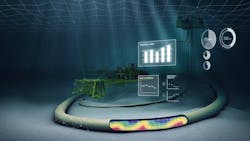Operators ramping up digital twin deployment
The offshore oil and gas industry is increasing its use of digital twin solutions as a means of improving operations, extending asset life, and enhancing worker safety. Digital twins are being used to digitize replicas of physical assets, with applications ranging from integrity management to training simulations and general visualization of remote infrastructure.
This trend of increased deployment was heightened by the recent downturn, according to a report from GlobalData. The report, “Digital Twins in Oil & Gas,” found that the downturn increased the need for cost reduction and improved overall asset visibility. Deploying digital twin solutions has been a key part of the industry's response.
“Companies have started to build models that will provide answers to ‘what if’ or ‘what will’ questions,” said Ravindra Puranik, Oil & Gas Analyst at GlobalData. “By replicating an asset or a portion of it in the virtual world, companies can run simulation tests on real-world problems and visualize the results in 3D. This is helping project engineers to improve their understanding of the asset, thereby enabling them to optimize its performance as per the market requirements. Thus, digital twins are gradually becoming integral to oil and gas operations.”
Like Internet of Things technologies, the lack of standardization has somewhat hampered the adoption of digital twins as well, the consultant said. To overcome this limitation, DNV, in collaboration with TechnipFMC, drafted a best practices guide for the creation and certification of digital twins in November 2020. It provides a framework for developers and users alike to understand the digital twins and extract the most out of their capabilities.
Ravindra added: “Newer oil and gas projects, such as Equinor’s Johan Sverdrup, or bp’s Clair Ridge are emerging as benchmarks in digital twin adoption. Companies such as Shell, Chevron, and Petrobras are launching initiatives to deploy digital twins across their global portfolio. With crucial support from oilfield technology and service companies, digital twins are likely to become mainstay for oil and gas operations in the coming years.”
More recently it was announced that Norske Shell will be using Kongsberg Digital’s Kognitwin Energy solution to create a virtual representation of the deepwater Ormen Lange gas field in the Norwegian Sea.
The Kognitwin Energy solution is a digital twin Software-as-a-Service platform that is designed to enable operators to integrate and contextualize data from their IT and OT systems. It also said to enable advanced process and flow simulation to drive higher degrees of asset performance and collaboration. In addition to data, workflows and simulation, the software enables an open ecosystem of applications through an API-driven integration approach, rooted in a principle of open standards and democratized innovation, Kongsberg Digital says.
Norske Shell and Kongsberg Digital say they plan to combine this with the onshore digital twin developed at the receiving Nyhamna gas processing facility to form what Kongsberg claims will be the first fully integrated reservoir-to-market digital twin.
They started collaborating in October 2019 to develop an “asset of the future.” The Nyhamna dynamic digital twin became operational soon afterwards and has been operating since January 2020. It is evolving continuously through monthly product releases, with a focus on safe and integrated work processes and optimization of production and energy use.
The first version of the Ormen Lange digital twin that followed, issued in June, mainly comprises data integrations and visualization of subsea 3D models, including production and MEG pipelines, well surface locations and wellbore paths, seabed bathymetry data around the production templates, documentation and drawings, and real-time DCS data.
For the subsea maintenance, wells, flow assurance, production technology, reservoir engineering, process engineering and operations, the twin provides unified data for everyone to access. Norske Shell aims to broaden development to specific use cases to provide its user groups, disciplines, and teams with new ways of working, Kongsberg Digital said.
Kongsberg Digital also reports that it has reached an agreement with ExxonMobil to explore the use of Kognitwin Energy dynamic digital twin software. Initial efforts will be focused on a new asset in ExxonMobil’s Guyana portfolio.
Digital twin solutions are being deployed elsewhere as well. Vår Energi has awarded 4Subsea a three-year service agreement to monitor and analyze wellhead integrity for the Balder Future drilling and completion operations in the Norwegian North Sea. The SWIM service, offered by 4Subsea, creates a digital twin of the well and riser systems combined with boundary conditions and updated with sensor data.
About the Author
Bruce Beaubouef
Managing Editor
Bruce Beaubouef is Managing Editor for Offshore magazine. In that capacity, he plans and oversees content for the magazine; writes features on technologies and trends for the magazine; writes news updates for the website; creates and moderates topical webinars; and creates videos that focus on offshore oil and gas and renewable energies. Beaubouef has been in the oil and gas trade media for 25 years, starting out as Editor of Hart’s Pipeline Digest in 1998. From there, he went on to serve as Associate Editor for Pipe Line and Gas Industry for Gulf Publishing for four years before rejoining Hart Publications as Editor of PipeLine and Gas Technology in 2003. He joined Offshore magazine as Managing Editor in 2010, at that time owned by PennWell Corp. Beaubouef earned his Ph.D. at the University of Houston in 1997, and his dissertation was published in book form by Texas A&M University Press in September 2007 as The Strategic Petroleum Reserve: U.S. Energy Security and Oil Politics, 1975-2005.

